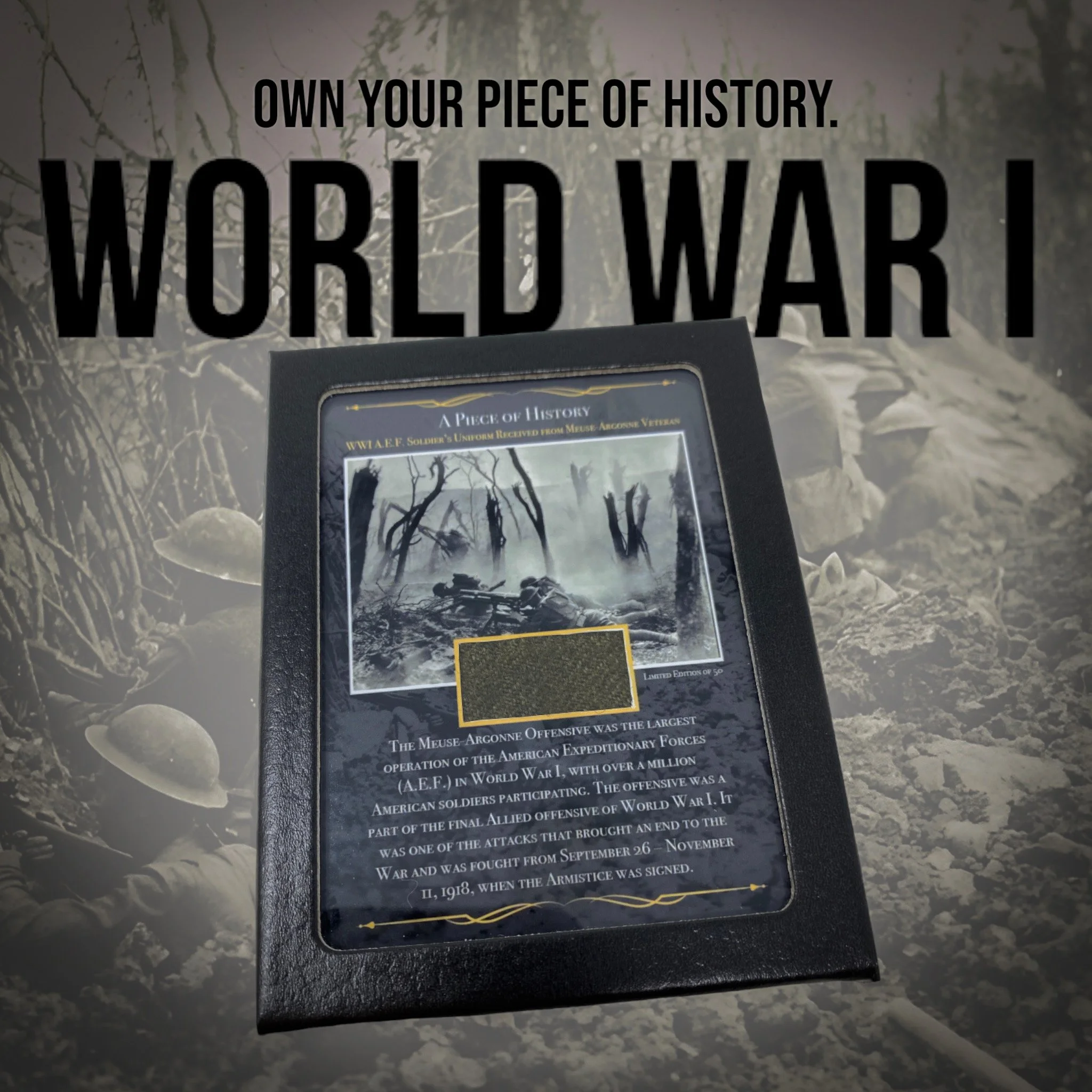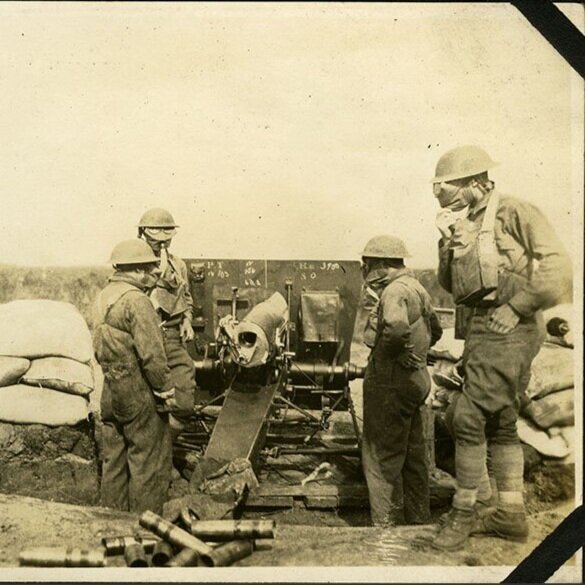RARE! WWI Meuse-Argonne Offensive 134th Field Artillery A.E.F. Soldier's Uniform with Display Case (C.O.A. Included)














RARE! WWI Meuse-Argonne Offensive 134th Field Artillery A.E.F. Soldier's Uniform with Display Case (C.O.A. Included)
Comes with a hand-signed C.O.A. and a full historical research write-up.
*Limited Edition of 50*
Own your piece of history today!
Due to an incredibly high demand for display case options we are proud to offer one of our LIMITED EDITION series of HISTORIC DISPLAY CASE EXCLUSIVES. This incredible “Piece of History“ is professionally encased in a glass display case with plush padding and a tightly sealed display case. Each displays features a historical photograph and short description that corresponds to the artifact displayed. This display case measures a perfect 4.25 inches tall x 3.25 inches wide.
This series is a limited edition of 50 pieces, meaning that each “Piece of History” display is unique. The glider artifact you receive may vary slightly from the display shown.
This incredibly rare and very historic piece of WWI history is an original American Expeditionary Force (A.E.F.) soldier’s uniform worn by 1st Lieut. E. V. McKey Jr. who was an A.E.F. artilleryman and saw extensive combat over the course of WWI serving valiantly with the 37th Infantry Division - 62nd Field Artillery Brigade -134th Field Artillery Regiment. The 62d Field Artillery Brigade - 134th Field Artillery is accredited battle participations in the Marbache sector where they provided extensive fire support and artillery barrages during the Meuse-Argonne offensive as well as the Thiaucourt sector during the St. Mihiel offensive. The 62nd Field Artillery Brigade is one of the most imfafous field artillery unit of World War I and as featured in some of the most historic photos still seen today. One of the most famous photos shows artillerymen from the 62nd Field Artillery Brigade, engaged in battle wearing gas masks to protect themselves from poison chemicals that were employed as weapons by all combatant forces during the war.
The Meuse-Argonne Offensive, launched in September 1918, was a crucial turning point for the Allies during World War I. The American Expeditionary Force (A.E.F.) played a significant role in this offensive, demonstrating its military prowess and making substantial contributions to the Allied victory. One of the key elements of the A.E.F.'s success was the effective utilization of artillery, particularly the A.E.F. Field Artillery Battalions. This essay will delve into the crucial role played by artillery and the specific missions and achievements of the A.E.F. Field Artillery Battalions during the Meuse-Argonne Offensive.
The Significance of Artillery in the Meuse-Argonne Offensive: Artillery was a crucial component of warfare during World War I, and its significance was no different in the Meuse-Argonne Offensive. The rugged terrain and heavily fortified German positions in the region necessitated the extensive use of artillery to soften defenses, destroy enemy strongholds, and provide cover for the advancing infantry. Artillery provided the firepower necessary to break through the enemy lines, neutralize German artillery, and pave the way for infantry advances.
Under the command of General John J. Pershing, the A.E.F. comprised a robust and well-organized artillery force, which included the Field Artillery Battalions. These battalions consisted of a combination of light, medium, and heavy artillery units, each designed to serve specific purposes on the battlefield.
The missions and specific contributions of the A.E.F. Field Artillery Battalions during the Meuse-Argonne Offensive were diverse and critical to the overall success of the offensive.
Softening Enemy Defenses: One of the primary objectives of the A.E.F. Field Artillery Battalions was to neutralize and weaken the enemy's defenses before the infantry assault. The artillery bombardments were meticulously planned, targeting enemy trench systems, barbed wire entanglements, and fortified positions. By suppressing German artillery and disrupting communication lines, the A.E.F. artillery prepared the ground for the advancing infantry and reduced the effectiveness of the enemy's counterattacks.
Counter-Battery Fire: The A.E.F. Field Artillery Battalions also engaged in counter-battery fire, targeting and neutralizing the enemy's artillery batteries. By effectively suppressing the German artillery, the A.E.F. limited their ability to provide support to their infantry and weakened their defensive capabilities. This crucial aspect of artillery warfare significantly increased the odds of success for the American infantry as they pushed forward.
Infantry Support: In addition to softening enemy defenses and neutralizing artillery, the A.E.F. Field Artillery Battalions played a vital role in supporting the infantry's advance. They provided cover fire, laid down smokescreens, and targeted specific enemy positions to facilitate the movement of American troops. This coordination between the artillery and infantry was vital to maintain the momentum of the offensive, minimize casualties, and maximize territorial gains.
Specialized Artillery Units: The A.E.F. Field Artillery Battalions included specialized units that brought unique capabilities to the battlefield. For instance, heavy artillery units, equipped with large-caliber guns, were instrumental in destroying concrete bunkers and other fortified positions that could not be easily eliminated by lighter artillery. Moreover, field howitzers provided close support to infantry units during the assault, delivering accurate and devastating firepower at close range.
Achievements and Impact: The A.E.F. Field Artillery Battalions made significant contributions to the success of the Meuse-Argonne Offensive. By effectively employing artillery, they not only shattered enemy defenses but also bolstered the morale and confidence of the American troops. The intense and relentless bombardments by the A.E.F. artillery disrupted German lines, forcing their troops to retreat and leading to the ultimate Allied victory in the offensive.
The offensive was not without challenges. The rugged terrain, logistical difficulties, and the resilience of the German defenses tested the mettle of the A.E.F. Field Artillery Battalions. Nevertheless, their adaptability, precision, and firepower played a crucial role in overcoming these obstacles and achieving the offensive's objectives.
The Meuse-Argonne Offensive marked a turning point in World War I, and the American Expeditionary Force, with its formidable Field Artillery Battalions, played a pivotal role in the Allied victory. The effective use of artillery softened enemy defenses, neutralized German artillery, and supported the advancing infantry. The A.E.F. Field Artillery Battalions' missions and accomplishments in the Meuse-Argonne Offensive demonstrated the significance of artillery power and its integration into successful military strategies. Their contributions and sacrifices exemplify the dedication and bravery of the American forces during this critical period in history.